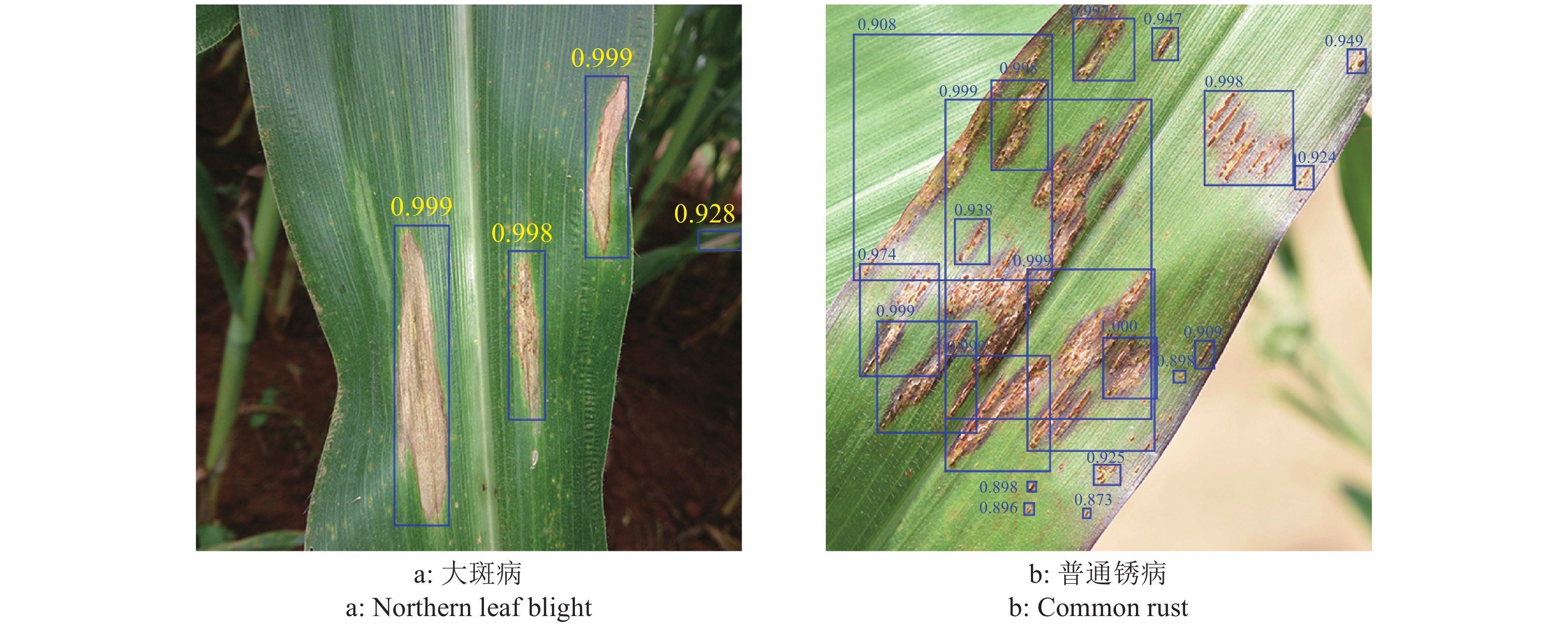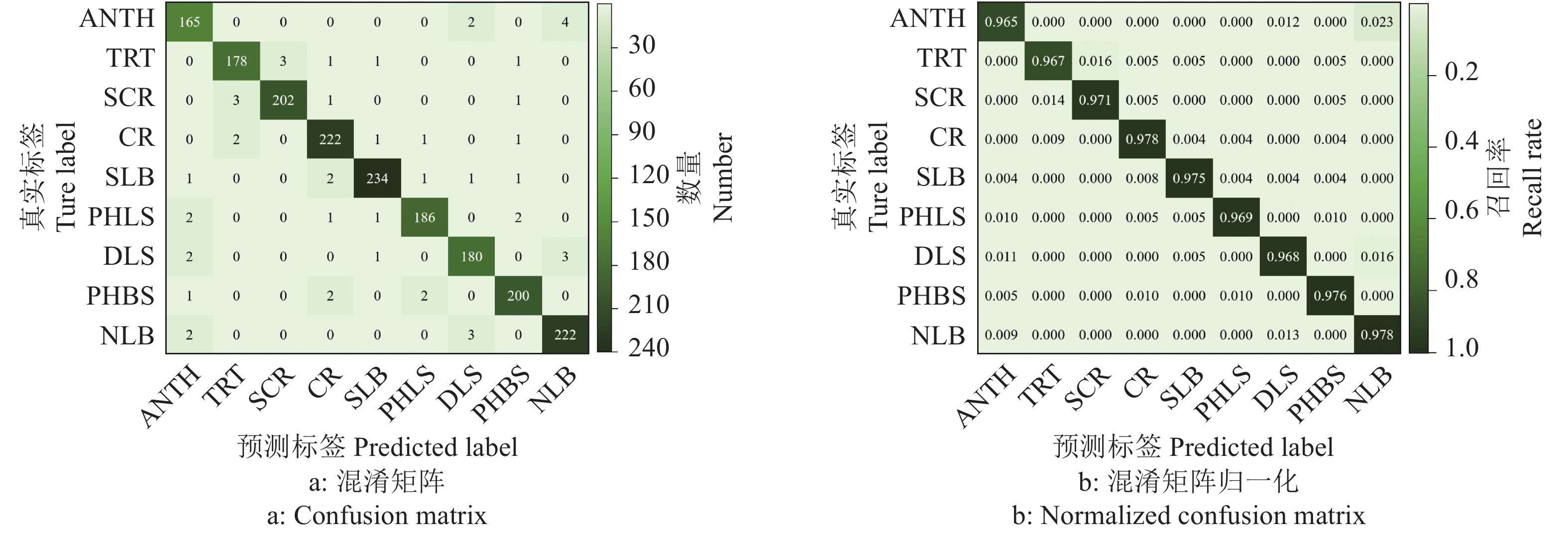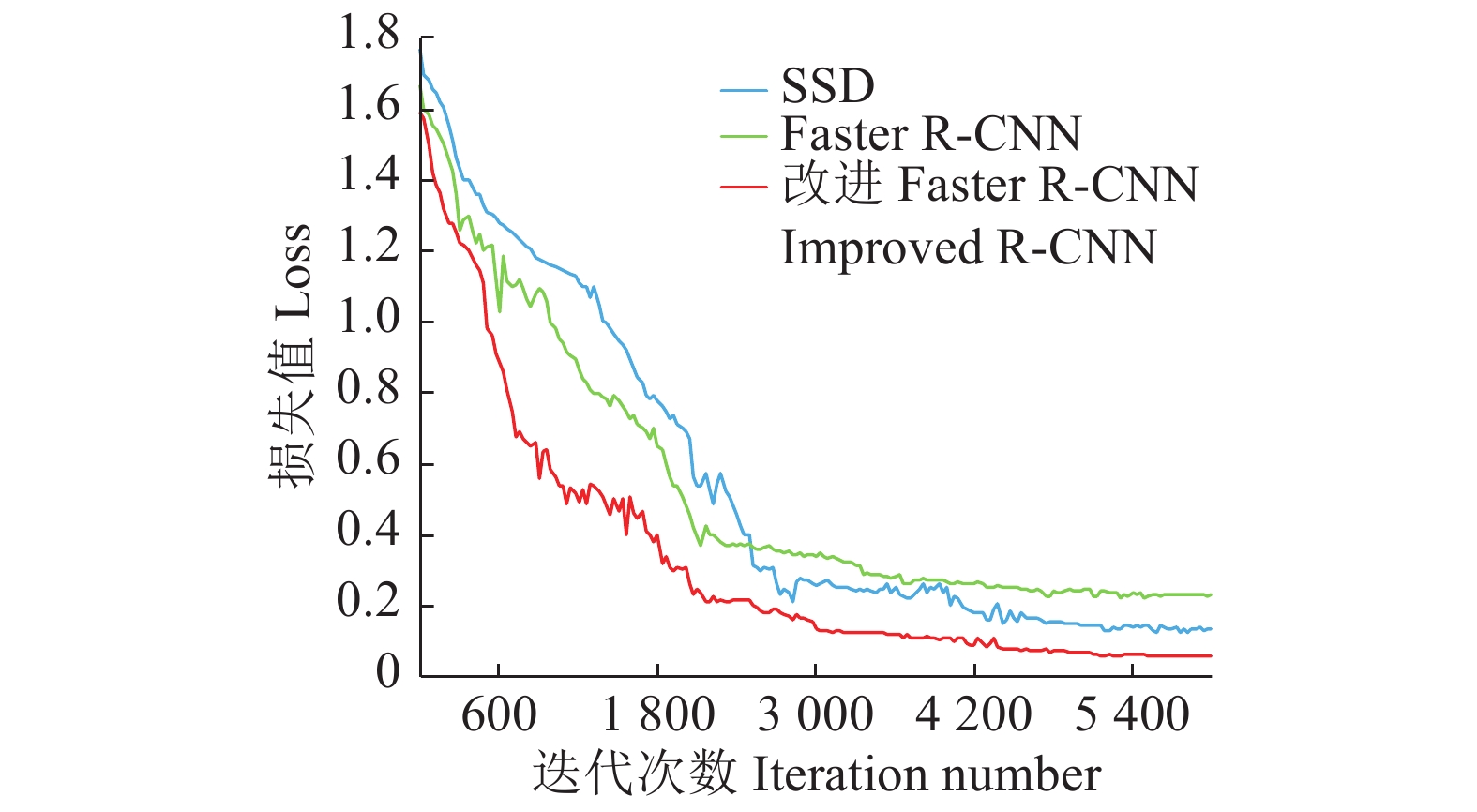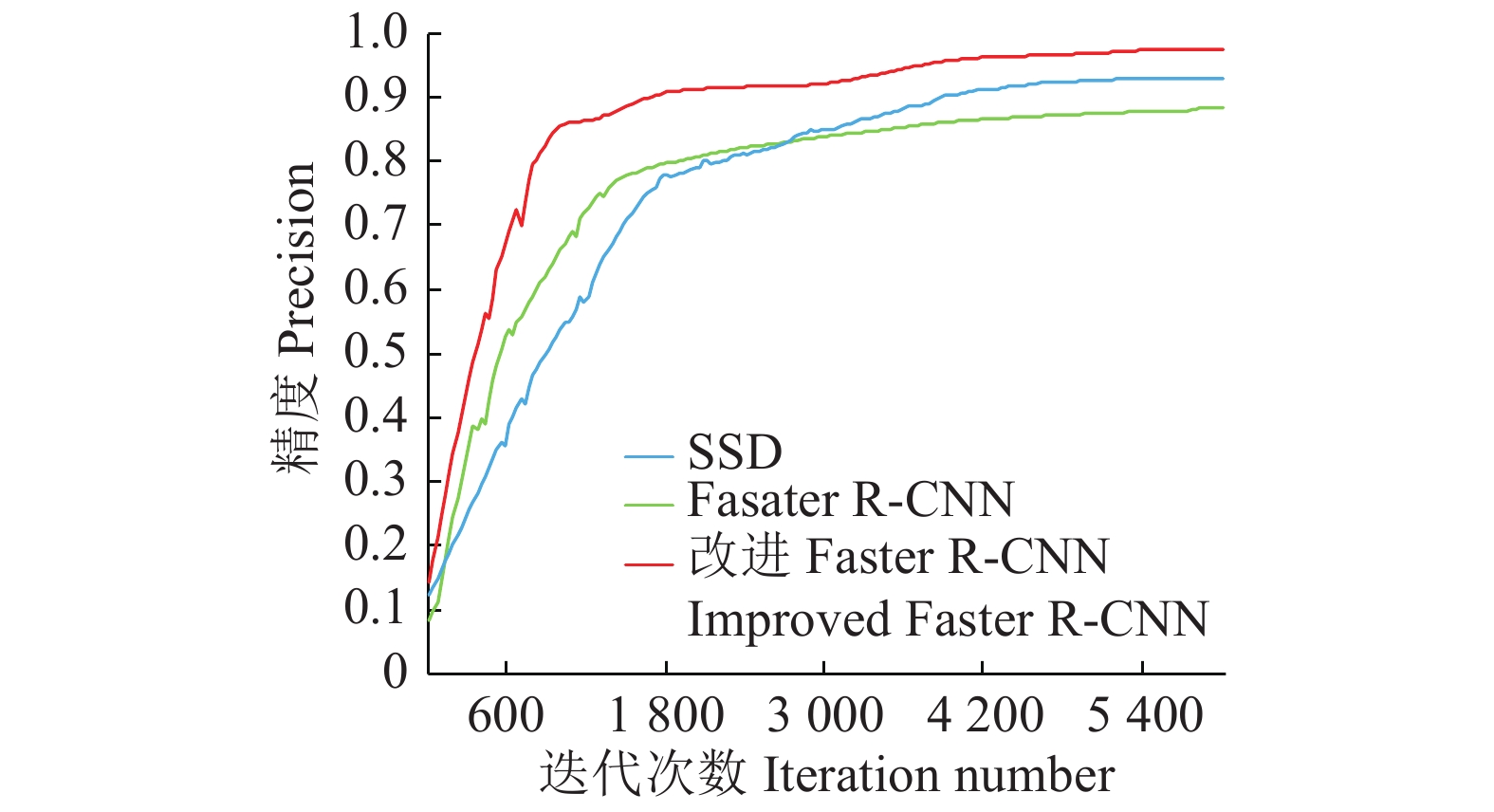Recognition of field maize leaf diseases based on improved regional convolutional neural network
-
摘要:目的
引入区域卷积神经网络Faster R-CNN算法并对其改进,以实现在田间真实环境下背景复杂且具有相似病斑特征的玉米病害的智能诊断。
方法在玉米田间和公开数据集网站获取具有复杂背景的9种常见病害图像1 150幅,人工标注后对原始图像进行离线数据增强扩充;对Faster R-CNN算法进行适应性改进,在卷积层加入批标准化处理层,引入中心代价函数构建混合代价函数,提高相似病斑的识别精度;采用随机梯度下降算法优化训练模型,分别选取4种预训练的卷积结构作为Faster R-CNN的特征提取网络进行训练,并测试得到最优特征提取网络,利用训练好的模型选取不同天气条件下的测试集进行对比,并将改进Faster R-CNN与未改进的Faster R-CNN和SSD算法进行对比试验。
结果在改进Faster R-CNN病害识别框架中,以VGG16卷积层结构作为特征提取网络具有更出色的性能,利用测试集图像检验模型,识别结果的平均精度为 0.971 8,平均召回率为0.971 9,F1为0.971 8,总体平均准确率可达97.23%;晴天的图像识别效果优于阴天的。改进Faster R-CNN算法与未改进的Faster R-CNN算法相比,平均精度高0.088 6,单张图像检测耗时减少0.139 s;与SSD算法相比,平均精度高0.0425,单张图像检测耗时减少0.018 s,表明在大田环境中具有复杂背景的玉米病害智能检测领域,改进Faster R-CNN算法综合性能优于未改进的Faster R-CNN算法和SSD算法。
结论将改进后的Faster R-CNN算法引入田间复杂条件下的玉米病害智能诊断是可行的,具有较高的准确率和较快的检测速度,能够避免传统人工识别的主观性,该方法为田间玉米病害的及时精准防控提供了依据。
Abstract:ObjectiveTo realize intelligent diagnosis of maize leaf diseases with similar spots and complicated background in real field conditions by introducing and improving a regional convolutional neural network algorithm, Faster R-CNN.
MethodWe obtained 1 150 maize leaf images with complicated background for nine kinds of common diseases from maize field and public dataset websites. After manual annotation of the original images, offline data augmentation was used to enlarge the image data. The Faster R-CNN algorithm was introduced and improved for adaptive application by adding batch normalization processing layer and introducing center cost function to improve the identification accuracy of similar disease spots. We used the stochastic gradient descent algorithm to train and optimize this model. Four pre-trained convolution structures for feature extraction were selected and compared in Faster R-CNN training and testing to get the most optimal model. During the test, the trained model was used to select test sets under different weather conditions for comparison, and improved Faster R-CNN was also compared with unimproved Faster R-CNN and SSD algorithm.
ResultIn the framework of improved Faster R-CNN, VGG16 convolutional feature extraction network had better performance than others. The testing image data set was used to verify the model performance, and the average precision of final recognition result was 0.971 8, the average recall rate was 0.971 9, F1 was 0.971 8, and the overall average accuracy reached 97.23%. The recognition effect under sunny conditions was better than that of cloudy conditions. The average precision of improved Faster R-CNN increased by 0.088 6 and the detection time per image decreased by 0.139 s compared with unimproved Faster R-CNN algorithm. The average precision of proposed method was 0.0425 higher than that of SSD algorithm, and the detection time per image decreased by 0.018 s. The results indicated that the improved Faster R-CNN algorithm was superior to unimproved Faster R-CNN and SSD algorithm in the field of intelligent detection of maize diseases under complex field conditions.
ConclusionIt is feasible to introduce improved Faster R-CNN algorithm into the intelligent diagnosis of maize diseases under complex field conditions, and it has higher accuracy and faster detection speed, which can avoid the subjectivity of traditional artificial identification. The proposed method lays a foundation for precise prevention and control of maize disease in field environment.
-
-
图 4 测试集分类结果的混淆矩阵分析
ANTH、TRT、SCR、CR、SLB、PHLS、DLS、PHRS、NLB分别代表炭疽叶斑病、热带锈病、南方锈病、普通锈病、小斑病、叶斑病、条纹病、褐斑病和大斑病;图中颜色较深的对角线的值分别代表每个类别正确分类的数量和召回率
Figure 4. Confusion matrix analysis of the classification results of testing dataset
ANTH, TRT, SCR, CR, SLB, PHLS, DLS, PHRS and NLB represent Anthracnose leaf blight, Tropical rust, Southern corn rust, Common rust, Southern leaf blight, Phaeosp haeria leaf spot, Diplodia leaf streak, Physoderma brown spot and Northern leaf blight respectively; The darker diagonal values in figures represent the number of correct classifications and the recall rate of each category, respectively
表 1 9种病害的图像样本情况
Table 1 Profile of sample images for nine types of diseases
病害名称
Disease name病原学名
Pathogenic name原始样本数
Number of original
samples增强后的样本数量
Number of augmented
samples标签
Label炭疽叶斑病 Anthracnose leaf blight Glomerella graminicola Politis 107 856 ANTH 热带锈病 Tropical rust Physopella pallescens 115 920 TRT 南方锈病 Southern corn rust Puccinia polysora 130 1 040 SCR 普通锈病 Common rust Puccinia sorghi 142 1 136 CR 小斑病 Southern leaf blight Bipolaris maydis 150 1 200 SLB 叶斑病 Phaeosphaeria leaf spot Phaeosphaeria variiseptata 120 960 PHLS 条纹病 Diplodia leaf streak Stenocarpella macrospora 116 928 DLS 褐斑病 Physoderma brown spot Physoderma maydis 128 1 024 PHBS 大斑病 Northern leaf blight Exserohilum turcicum 142 1 136 NLB 合计 Total 1 150 9 200 表 2 共享卷积层不同特征提取网络的在测试集上的性能
Table 2 Performance of different feature extraction networks in shared convolutional layer on testing dataset
特征提取网络类型
Type of feature extraction network平均准确率/%
Average accuracy单张图像检测耗时/s
Detection time per imageAlexNet 91.73 0.243 VGG16 97.23 0.278 ResNet50 88.97 0.437 ResNet101 86.03 0.572 表 3 测试集混淆矩阵分析统计参数1)
Table 3 Statistical parameters from the confusion matrix analysis of testing dataset
参数 Parameter ANTH TRT SCR CR SLB PHLS DLS PHBS NLB 图像总数 Total number of images 856 920 1040 1136 1200 960 928 1024 1136 阳性测试例数 Number of positives 171 184 208 227 240 192 186 205 227 阴性测试例数 Number of negatives 1669 1656 1632 1613 1600 1648 1654 1635 1613 预测为正的正样本 True positive 165 178 202 222 234 186 180 200 222 预测为负的正样本 False negative 6 6 6 5 6 6 6 5 5 预测为正的负样本 True negative 1624 1611 1587 1567 1555 1603 1609 1589 1567 预测为负的负样本 False positive 8 5 3 7 4 4 7 6 7 召回率 Recall 0.965 0.967 0.971 0.978 0.975 0.969 0.968 0.976 0.978 精度 Precision 0.954 0.973 0.985 0.969 0.983 0.979 0.963 0.971 0.969 综合评价指标(F1) Comprehensive evaluation index 0.959 0.970 0.978 0.974 0.979 0.974 0.965 0.973 0.974 平均准确率/% Average accuracy 97.23 1) ANTH、TRT、SCR、CR、SLB、PHLS、DLS、PHRS、NLB分别代表炭疽叶斑病、热带锈病、南方锈病、普通锈病、小斑病、叶斑病、条纹病、褐斑病和大斑病
1) ANTH, TRT, SCR, CR, SLB, PHLS, DLS, PHRS and NLB represent Anthracnose leaf blight, Tropical rust, Southern corn rust, Common rust, Southern leaf blight, Phaeosphaeria leaf spot, Diplodia leaf streak, Physoderma brown spot and Northern leaf blight respectively表 4 不同分类检测算法检测结果的比较
Table 4 Comparison of the detection results for different classification and detection algorithms
算法
Algorithm精度
Precision单张图像检测耗时/s
Detection time per imageSSD 0.929 3 0.296 Faster R-CNN 0.883 2 0.417 改进 Faster R-CNN Improved Faster R-CNN 0.971 8 0.278 -
[1] 许景辉, 邵明烨, 王一琛, 等. 基于迁移学习的卷积神经网络玉米病害图像识别[J]. 农业机械学报, 2020, 51(2): 230-236. doi: 10.6041/j.issn.1000-1298.2020.02.025 [2] 李静, 陈桂芬, 安宇. 基于优化卷积神经网络的玉米螟虫害图像识别[J]. 华南农业大学学报, 2020, 41(3): 110-116. doi: 10.7671/j.issn.1001-411X.201907017 [3] SINGH A K, GANAPATHYSUBRAMANIAN B, SARKAR S, et al. Deep learning for plant stress phenotyping: Trends and future perspectives[J]. Trends Plant Sci, 2018, 23(10): 883-898. doi: 10.1016/j.tplants.2018.07.004
[4] 张明, 王腾, 李鹏, 等. 基于区域亮度自适应校正算法的脐橙表面缺陷检测[J]. 中国农业科学, 2020, 53(12): 2360-2370. doi: 10.3864/j.issn.0578-1752.2020.12.005 [5] 张芳, 王璐, 付立思, 等. 基于支持向量机的黄瓜叶部病害的识别研究[J]. 沈阳农业大学学报, 2014, 45(4): 457-462. doi: 10.3969/j.issn.1000-1700.2014.04.014 [6] 张开兴, 吕高龙, 贾浩, 等. 基于图像处理和BP神经网络的玉米叶部病害识别[J]. 中国农机化学报, 2019, 40(8): 122-126. [7] 党满意, 孟庆魁, 谷芳, 等. 基于机器视觉的马铃薯晚疫病快速识别[J]. 农业工程学报, 2020, 36(2): 193-200. doi: 10.11975/j.issn.1002-6819.2020.02.023 [8] SINGH V, MISRA A K. Detection of plant leaf diseases using image segmentation and soft computing techniques[J]. Information Processing in Agriculture, 2016, 4(1): 41-49.
[9] 赖君臣, 李少昆, 明博, 等. 作物病害机器视觉诊断研究进展[J]. 中国农业科学, 2009, 42(4): 1215-1221. doi: 10.3864/j.issn.0578-1752.2009.04.012 [10] 刘涛, 仲晓春, 孙成明, 等. 基于计算机视觉的水稻叶部病害识别研究[J]. 中国农业科学, 2014, 47(4): 664-674. doi: 10.3864/j.issn.0578-1752.2014.04.006 [11] 毛彦东, 宫鹤. 基于SVM和DS证据理论融合多特征的玉米病害识别研究[J]. 中国农机化学报, 2020, 41(4): 152-157. [12] 赵立新, 侯发东, 吕正超, 等. 基于迁移学习的棉花叶部病虫害图像识别[J]. 农业工程学报, 2020, 36(7): 184-191. doi: 10.11975/j.issn.1002-6819.2020.07.021 [13] 姜洪权, 贺帅, 高建民, 等. 一种改进卷积神经网络模型的焊缝缺陷识别方法[J]. 机械工程学报, 2020, 56(8): 235-242. [14] 董秋成, 吴爱国, 董娜, 等. 用于卷积神经网络图像预处理的目标中心化算法[J]. 中南大学学报(自然科学版), 2019, 50(3): 89-96. [15] BRAHIMI M, BOUKHALFA K, MOUSSAOUI A. Deep learning for tomato diseases: Classification and symptoms visualization[J]. Appl Artif Intell, 2017, 31(4): 299-315. doi: 10.1080/08839514.2017.1315516
[16] FERENTINOS K P. Deep learning models for plant disease detection and diagnosis[J]. Comput Electron Agr, 2018, 145: 311-318. doi: 10.1016/j.compag.2018.01.009
[17] 孙俊, 谭文军, 毛罕平, 等. 基于改进卷积神经网络的多种植物叶片病害识别[J]. 农业工程学报, 2017, 33(19): 209-215. doi: 10.11975/j.issn.1002-6819.2017.19.027 [18] 龙满生, 欧阳春娟, 刘欢, 等. 基于卷积神经网络与迁移学习的油茶病害图像识别[J]. 农业工程学报, 2018, 34(18): 194-201. doi: 10.11975/j.issn.1002-6819.2018.18.024 [19] KERKECH M, HAFIANE A, CANALS R. Deep learning approach with colorimetric spaces and vegetation indices for vine diseases detection in UAV images[J]. Comput Electron Agr, 2018, 155(12): 237-243.
[20] 戴泽翰, 郑正, 黄莉舒, 等. 基于深度卷积神经网络的柑橘黄龙病症状识别[J]. 华南农业大学学报, 2020, 41(4): 111-119. doi: 10.7671/j.issn.1001-411X.201909031 [21] 李淼, 王敬贤, 李华龙, 等. 基于 CNN 和迁移学习的农作物病害识别方法研究[J]. 智慧农业, 2019, 1(3): 46-55. [22] 杨森, 冯全, 张建华, 等. 基于深度学习与复合字典的马铃薯病害识别方法[J]. 农业机械学报, 2020, 51(7): 22-29. doi: 10.6041/j.issn.1000-1298.2020.07.003 [23] TOO E C, LI Y J, NJUKI S, et al. A comparative study of fine-tuning deep learning models for plant disease identification[J]. Comput Electron Agr, 2019(161): 272-279.
[24] 鲍文霞, 孙庆, 胡根生, 等. 基于多路卷积神经网络的大田小麦赤霉病图像识别[J]. 农业工程学报, 2020, 36(11): 174-181. doi: 10.11975/j.issn.1002-6819.2020.11.020 [25] 任守纲, 贾馥玮, 顾兴健, 等. 反卷积引导的番茄叶部病害识别及病斑分割模型[J]. 农业工程学报, 2020, 36(12): 186-195. doi: 10.11975/j.issn.1002-6819.2020.12.023 [26] 宋余庆, 谢熹, 刘哲, 等. 基于多层特征融合的农作物病虫害识别方法[DB/OL].[2020-06-09]. http://kns.cnki.net/kcms/detail/11.1964.S.20200515.1754.010.html. [27] 王晓鸣, 段灿星. 玉米病害和病原名称整理及其汉译名称规范化探讨[J]. 中国农业科学, 2020, 53(2): 288-316. doi: 10.3864/j.issn.0578-1752.2020.02.006 [28] REN S, HE K M, GIRSHICK R, et al. Faster R- CNN: Towards real-time object detection with region proposal net-works[C]//NIPS. Proceedings of Advances in Neural Information Processing Systems. Montreal, Quebec, Canada: NIPS, 2015: 91-99.
-
期刊类型引用(4)
1. 张才用,陈指龙,谢浩,彭翠婷,晏超,赵玉兰,齐霖,周磊,唐中林. 提高猪体细胞克隆胚胎发育率的研究进展. 中国农业科技导报. 2024(12): 201-209 .  百度学术
百度学术
2. 陈振鹏,刘瑞莉,张文琦,董雅娟,柏学进. 布莱凯特黑牛胎盘印记和营养转运基因表达及其与初生重相关性分析. 黑龙江畜牧兽医. 2024(24): 35-42+136-137 .  百度学术
百度学术
3. 曹嘉程,薛丽娥,蓝群,饶勇勇,陈德军,林瑞意,肖天放. 表观遗传修饰影响哺乳动物体细胞核移植效率的研究进展. 中国畜牧杂志. 2023(03): 7-15 .  百度学术
百度学术
4. 乔木,吴俊静,彭先文,梅书棋. 猪NNAT基因印记鉴定及单核苷酸多态性分析. 中国畜牧杂志. 2021(S1): 29-32 .  百度学术
百度学术
其他类型引用(0)



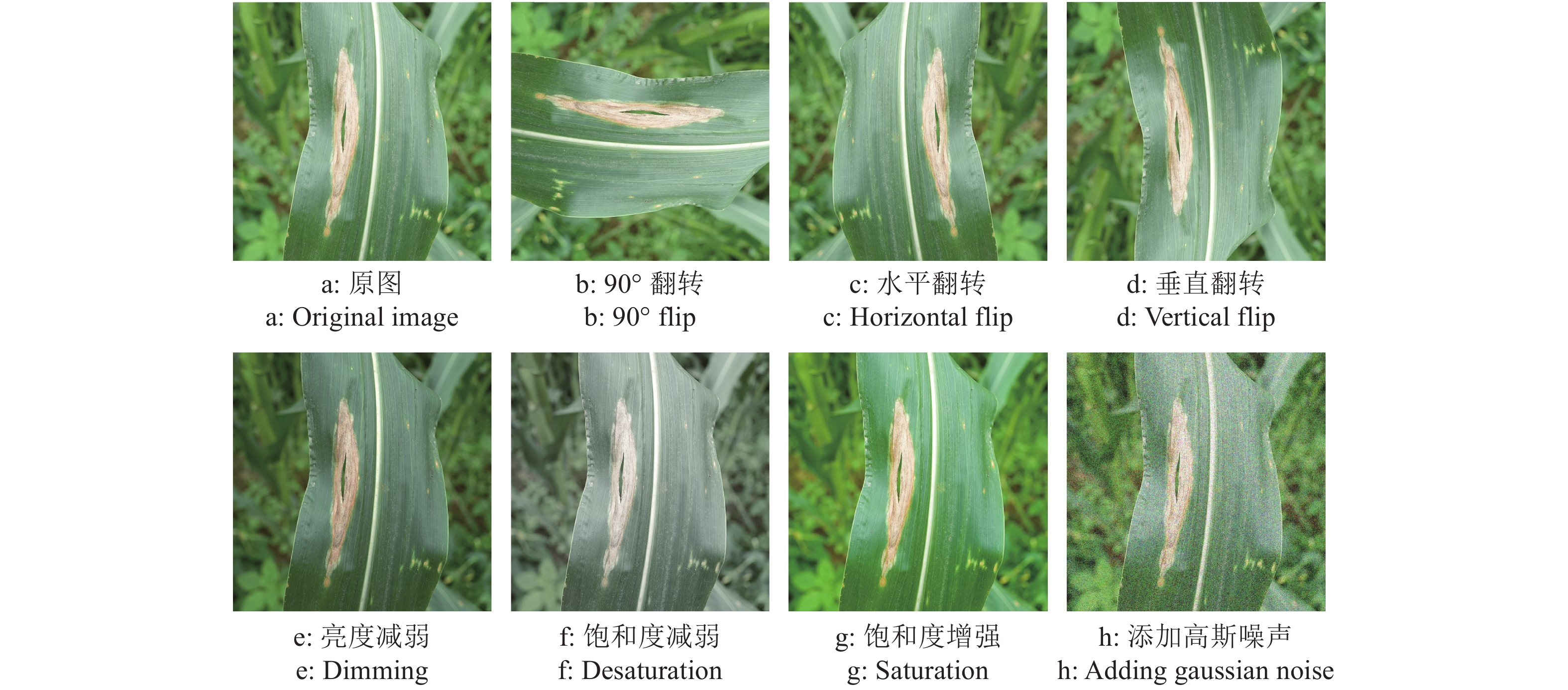
 下载:
下载:

